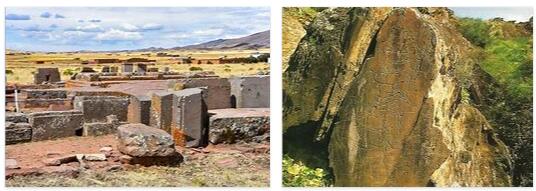The Côa Valley in northeastern Portugal is a Stone Age picture gallery. The rock walls have been provided with pictures and stone carvings over a distance of around 17 km for thousands of years. Some of them are over 25,000 years old. They document the long history of settlements and the way people live.
Rock Carvings in Portugal and Spain: Facts
| Official title: | Prehistoric rock carvings in the Côa Valley (Portugal) and Siega Verde (Spain) |
| Cultural monument: | the only site in the world where prehistoric and contemporary rock art can be found at the same time; rock carvings on partially unprotected (!) rock faces that have been intensively publicized since 1994, carvings between 50 cm and 1.5 m in size and over an area of 15 km; temporarily threatened by the construction of a dam; Sites Canada do Inferno, Ribeira de Piscos and Penascosa; Canada do Inferno with 36 rocks and carvings, which have been covered by shallow water since 1983, there depictions of aurochs, ibex, horses and fish, but also contemporary religious motifs such as monstrances and crosses and a depiction of a railway of the Douro line that crosses the mouth des Côa crossed; also in Penascosa depictions of aurochs and ibex, but also a pairing of mare and stallion with three heads as a means of expression for the up and down movement of the head while riding; in Ribeira de Piscos et al. Depiction of two horses crossing their heads and a human figure over an aurochs, intensive research on site since 1995; 2010 expanded to include 600 paleolithic rock carvings of animals and figures in Siega Verde, Spain |
| Continent: | Europe |
| Country: | Portugal, Spain |
| Location: | Côa Valley, southeast of Vila Nova de Foz Côa in Portugal and Siega Verde, Spain |
| Appointment: | 1998, extended in 2010 |
| Meaning: | unique rock carvings from the Paleolithic to the 20th century. |
Aurochs, deer and…
The collection of Paleolithic rock art in the Côa Valley in Portugal and in Siega Verde in the Spanish province of Salamanca is one of the most extensive finds of its kind: In the course of archaeological research, scientists classified numerous individual finds at various places along the banks of the Côa, a tributary of the Douro, as well as 645 incisions in Spain. What is particularly surprising about the rock paintings is the fact that they are not to be found in caves or below rock roofs, but on craggy rock faces that are exposed to the rigors of wind and rain.
With their technically and aesthetically high-quality motifs, the rock paintings tie in with the »image catalog« of Pleistocene art in Western Europe, which is predominantly determined by zoomorphic and naturalistic motifs. Horses, aurochs, goats and chamois, but also deer and roe deer are predominant images. These are complemented by rare fish, and human representations have even been discovered on two rock faces.
The majority of the motifs are carved or carved in stone. The contours of some incised and red-painted aurochs are located upstream in Faia, and only in places protected from the weather. This leads to the conclusion that perhaps other motifs, of which one can only guess the outlines today, were originally also painted. With the exception of Faia, where the river gapes the granite ceiling, all other rock carvings are on schist-greywacke rocks.
The majority of the motifs appear sporadically and they seem to float in an »idealized space«. There is no evidence of a landscape covered with plants. Scenes or compositions, among which the most impressive shows two horses with intertwined heads, are rather rare. Here and there one finds scratches in a »dynamic style«: depictions of animals with several heads, which are supposed to suggest movement. Similar to other cultures that left rock paintings – such as the Aborigines who once lived in the Australian Kakadu National Park – several animal images were probably deliberately “drawn” on top of each other. Often overpainted rocks represent true “stone palimpsests” – this is how old manuscripts on parchment or papyrus are called that were created
The last excavation at Rocha I do Farizeu, a rock face with multi-layered engravings, all of which have the form and style peculiarities of rock art in the Côa Valley, took place in December 1999. Above these engravings there are finally layers, the Paleolithic cultural stages from the Proto-Solutréen (around 20,000 to 16,000 BC) to the Magdalenian (around 16,000 to 12,000 BC).
The ritualized arrangement on the decorated places, which were found particularly on the banks of the Côa, are signs of the monumentalization of the landscape with the herbivore fauna. It has existed since the Gravettian epoch and continues – although with fewer layers and greater expanse – probably into the Old Magdalenian. During this long period of time, the Côa Valley was regarded as a place of worship that several generations of “artistically” active hunters visited and adorned during the Paleolithic.
